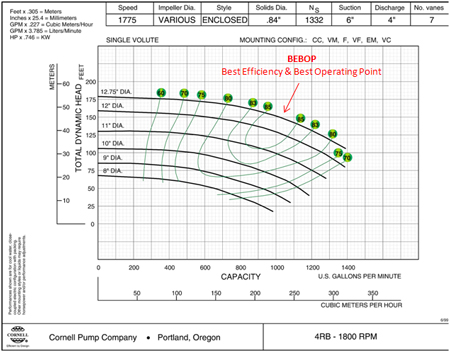The rise of bebop in the 40s and 50s had a major effect on the style and sound of both jazz and rock and roll. As a drummer with a jazz quartet during my college years, the bebop artists of the 50s and 60s were my idols. Unfortunately, jazz did not compete well with other musical venues of the period so our only pay was free drinks at the local bars where we played a couple of nights each week. We paid for our college expenses by playing "businessman's bounce" for the country club folks on the weekends.
So, what does bebop have to do with pumping systems? During my training seminars I have found that most of my students are familiar with the best efficiency point (BEP) on a pump's head/capacity curve. They understand it is the point at which the highest hydraulic efficiency occurs. But, they also think that efficiency is the only reason that BEP should be the preferred operating point. After all, the higher the hydraulic efficiency, the lower the cost per gallon pumped.
What most do not recognize is that there is another equally, or even more important, reason that pumps should be operated as close to BEP as possible. BEP is also the point at which a pump is least prone to failure and its life expectancy is greatest. In other words, it is also a pump's best operating point (BOP).
I redefined the term BEBOP (best efficiency/best operating point) to illustrate the importance of both, and I use it in all of my pump seminars. I do not expect to go down in the annals of pump history for this not-so-notable achievement nor do I expect to be nominated for the Nobel Peace Prize, but I do hope it will cause people to consider BEP from a wider perspective.
Many of my previous Pumps & Systems columns have focused on the BOP part of BEBOP operation. Several have addressed the damage that can be caused by unbalanced radial forces that arise during off BOP operation. Others have focused on the types of recirculation cavitation damage that can occur under similar operating conditions. I have also addressed hydraulic efficiency and the financial impact of off BEP operation. Numerous other articles by other authors have also discussed the multitude of problems that can occur during off BEP operation. In my opinion, BOP trumps BEP in importance over the long term, but if you pay attention to BOP, BEP operation is also satisfied.
Figure 1 is a screenshot of one of the PowerPoint screens I use in my seminars. Whenever we discuss pump performance curves, BEP is replaced with BEBOP and Gene Vincent's 1956 rock and roll hit, "Be-Bop-A-Lula," is playing in the background. Maybe this is a bit over the top, but i have found that it definitely gets my point across.

Figure 1: Best efficiency/best operating point (BEBOP)

